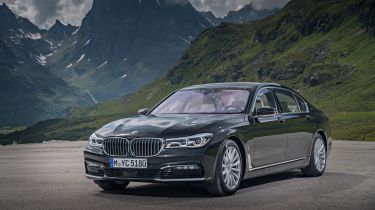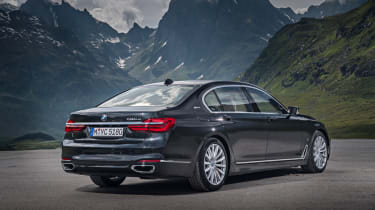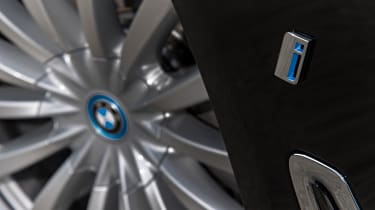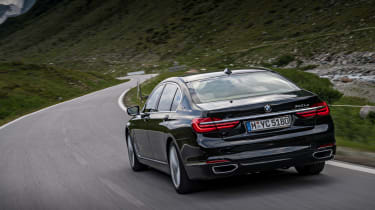BMW 740e iPerformance hybrid (2016-2018)
“The BMW 740e adds lower running cost to the top-rung BMW’s broad list of talents”
Pros
- Low company-car tax
- Luxurious interior
- Smooth ride
Cons
- Long options list
- Not especially elegant
- Economy figures may be hard to achieve
BMW’s 7 Series saloon has been the range flagship since the late seventies and competes with the Audi A8 and Mercedes S-Class for attention from high-ranking corporate executives and private buyers with a taste for luxury. The addition of diesel versions has broadened the range’s appeal in recent years and the 740e iPerformance promises a hi-tech approach to reducing running costs.
It’s the top offering from BMW’s range of plug-in hybrid cars and combines a powerful petrol engine with an electric motor. This enables zero-emissions urban motoring for a limited distance and greatly reduced average CO2 emissions and fuel consumption. The 740e fights for sales against the Mercedes S500e and Audi A8 e-tron in the hybrid luxury saloon class.
The plug-in hybrid 7 Series is available in two forms – the regular-wheelbase 740e and the longer, more spacious 740Le, which has BMW’s xDrive four-wheel-drive system as standard. Externally, only eDrive badging sets either apart from their petrol and diesel-fuelled stablemates, with a charging socket behind a flap ahead of the left front door acting as a recognition point on debadged examples.
The BMW 740e iPerformance uses a 2.0-litre, twin-turbocharged petrol engine that produces 254bhp, boosted by a transmission-mounted electric motor. The total power available is 321bhp; when called to, the 740e can accelerate from 0-62mph in 5.4 seconds. Four-wheel-drive xDrive cars are a tenth of a second quicker.
More reviews
Assuming the electric motor is used wherever possible, the 740e claims fuel consumption of up to 134.5mpg combined with CO2 emissions as low as 49g/km. This puts the biggest BMW in the lowest 9% Benefit-in-Kind (BiK) company-car tax bracket, representing a huge tax saving over the 30% BiK rating of the petrol 740Li.
This is made especially appealing by the 740e having the lowest P11D taxable value of any non-diesel 7 Series, even though though a Government plug-in grant isn’t available, as its list price is above £60,000. However, the entry-level 725d diesel still undercuts it markedly, and with 61.4mpg claimed to be possible, will likely be more cost-effective for high-mileage users.
The 740e’s appeal will be recognised most by those who often travel in congested cities. All versions are exempt from the London Congestion Charge and its electric motor enables near-silent stop-start driving for up to a claimed 27 miles at up to 87mph. The electric power system makes its presence felt as soon as you put your foot down, with instantaneous response where a fossil-fuel-burning engine alone will typically hesitate for a moment.
It’s a hit for calm, nippy urban driving, then, and as capable as any other 7 Series when you go beyond the city limits. The 7 Series is arguably the most entertaining of all the large luxury saloons to drive; it’s agile and obedient when driven swiftly on challenging roads and extremely smooth and quiet at motorway speeds.
In all, the 740e plug-in hybrid should perhaps not be seen as a hi-tech alternative, but as a thoroughly sensible entry-level model in the petrol 7 Series range. Some will find it extremely cost-effective to run, but everybody will enjoy its unruffled comfort and effortless power.
MPG, running costs & CO2
It’s hard to understate the significance of the 740e’s main draw. Some models claim official CO2 emissions of 49g/km, placing them in the lowest 9% Benefit-in-Kind (BiK) bracket for company-car users. For many, that’ll represent a huge tax saving, compared even to the entry-level 725d diesel version, which sits in the 26% bracket.
Choosing the long-wheelbase 740Le xDrive four-wheel-drive version increases BiK to 13% and also reduces fuel economy slightly to 117.7mpg on the smallest 18-inch wheels. Increase to 19 or 20-inch wheels and economy drops to 113mpg exactly. However, this is still an astonishing figure for a large luxury saloon and regular-wheelbase models are claimed to return up to 134.5mpg.
If low fuel consumption is your primary buying motive, it should be remembered that these figures are based on the plug-in hybrid system operating at peak efficiency. This means keeping the lithium-ion battery fully charged, an operation that takes less than three hours using an optional fast-charging wall box.
To take full advantage of the hybrid system, you’ll need to make a high percentage of your journeys in stop-start traffic, where slow driving conditions are regularly encountered. If your usual routine is heavily biased towards fast motorway driving, you’re likely to see fuel economy closer to that of a regular petrol car.
Other running costs, including routine servicing, will be similar to other models in the 7 Series range, although BMW can arrange a service package to cover your first five services. Maintenance visits are determined by a monitoring system that analyses oil quality and component condition. BMW offers a three-year/unlimited-mileage warranty on all its cars, and the 740e’s battery is covered by a separate eight-year/100,000-mile guarantee.
Insurance, meanwhile, is likely to be costly. The entry-level model is rated in group 47, although large luxury rivals are rated as a similarly high insurance risk. As it costs more than £40,000 to buy, every 7 Series will cost £450 the first five times you renew its yearly road-fund license, after which it falls to £140 annually.
Engines, drive & performance
The 740e is the only BMW 7 Series to use a four-cylinder engine – other models use either a six or eight-cylinder engine. The result is a slight lack of smoothness – the 2.0-litre twin-turbocharged engine can’t match the silky feel of the 740i’s twin-turbocharged ‘six’.
However, if you haven’t experienced the smoothness of the pricier 740i, you won’t realise it’s missing in the 740e. For the most part, it’s still extremely subdued and plenty of sound insulation means it never becomes intrusive – it’s just less tuneful than more expensive models.
There’s certainly no lack of power, as borne out by a rapid 0-62mph time of 5.4 seconds, courtesy of a grand total of 321bhp when electric and petrol power are combined. The immediate response of the electric motor means there’s no hesitation when you pull away from a standstill, so the first few seconds of acceleration feel very sharp indeed. Only as the petrol engine takes over the heavy-lifting do the more powerful six-cylinder models begin to catch up when measured against the clock.
The electric motor also serves to act as a booster when overtaking power is called on, disguising the delay as the engine’s two turbochargers spin into action. The eight-speed automatic gearbox is extremely smooth, and motorway travel completely effortless. The same is true of country roads, too – no 7 Series is as compact and nimble as BMW’s smaller cars, but feels very agile for such a large car.
An enthusiastic driver certainly won’t be disappointed by the 740e’s responses – the extra weight of its plug-in hybrid system is negated by its smaller, lighter engine. Likewise, the extra bulk of the longer 740Le version is offset by the extra traction of xDrive four-wheel drive, reducing 0-62mph by a tenth of a second and introducing benefits for those who regularly travel on greasy roads.
Interior & comfort
Of all the super-luxury saloons, the BMW 7 Series is arguably the most adept at combining driver appeal with a truly cosseting passenger experience, and nowhere is this better exemplified than from behind the wheel.
The 7 Series feels a little more formal and businesslike than some rivals – a BMW trait that dates back through the generations. The dashboard could even be charged with being a little austere, if it wasn’t peppered with high technology and convenience features.
The dashboard is dominated by a 10.25-inch high-resolution touchscreen, which uses swipe and gesture recognition to access the various functions of an infotainment system incorporating DAB radio and BMW’s Professional Multimedia system. Sat nav is included, of course, and there’s a reversing assist camera and hi-fi speaker system. BMW's 'remote services' also mean you can lock and unlock your 7 Series, set its climate control, or just check on its location and trip computer from your smartphone.
Long-wheelbase 740Le models also add an electric glass sunroof and roller sunblind for the rear windscreen. Features exclusive to the iPerformance plug-in hybrid include additional energy management information for the ‘black panel’ instrument cluster and door-sill finishers with an eDrive inscription. The recharging socket is illuminated and a five-metre charging cable is supplied.
The top iPerformance model is the 740Le xDrive Exclusive, which affords those in the rear an even more luxurious travelling environment. Features include BMW Gesture Control on a separate tablet-style touchscreen, mounted between two multi-adjustable ‘Comfort’ rear seats. Soft-close doors are fitted and there’s a ‘pure excellence’ exterior design package with additional chrome details.
Practicality & boot space
When it comes to practicality, the 7 Series and was conceived to meet the needs of the business traveller, rather than the hectic rigours of family life. Load-carrying isn’t a priority, although the large size of such cars means they have a big boot as a happy coincidence. In fact, the 740e boasts 515 litres’ luggage capacity and is claimed to easily swallow a full set of golf clubs. There’s no option for a folding rear seat, though, so long items may require alternative transport.
The regular-length 740e offers loads of space whether you’re in a front or rear seat, but the 740Le is 14cm longer for a truly first-class rear passenger compartment. Buyers can choose from a standard three-seat bench or two reclining ‘comfort’ seats akin to armchairs. Few could possibly have reason to complain of restricted space, although legroom is in more plentiful supply than headroom.
If you’re not sitting behind the driver, even more lounging space is available if you move the passenger seat forwards, simply by pressing a button. Exclusive models also offer a seven-inch tablet with BMW Gesture Control to access optional features, such as the rear-seat massage function and BMW concierge services.
All of these features and benefits point to the 740e and 740Le being well placed for VIP transport, particularly in urban areas where its potential for low fuel consumption can be exploited.
Reliability & safety
As this is the top model in BMW’s range, 7 Series customers have a right to expect high standards of service from the German company and its representatives. Although too few 7 Series owners have participated in our Driver Power survey to give an accurate impression of life with this particular model, it does seem that BMW ownership is generally satisfying.
BMW finished ninth overall out of 27 brands surveyed.12.4% of owners reported one or more faults with their car within the first twelve months of ownership, earning the brand a 9th place finish for reliability. One category in which BMW fell behind was for running costs – owners rated routine servicing as expensive. Few owners seem too enamoured by their car’s exterior looks, either.
Where a BMW really shines, according to our survey, is in its engines, gearboxes, ride and handling, all of which are areas in which the 740e excels even when compared to its most talented rivals.
Unlike cars that sell in higher volumes, the 7 Series hasn’t been crash-tested independently by Euro NCAP. However, it offers similar safety equipment to other cars in the BMW range. Driver assistance systems are on hand to mitigate the risk of a collision: a ‘driving assistant’ package is available with forward collision and lane-departure warning, as well as a dashboard speed-limit display.
An upgraded system called ‘driving assistant plus’ offers active cruise control that incorporates autonomous emergency braking. It also provides lane-keeping assistance and an evasion aid, which will automatically steer the car around obstructions at low speed.
Price, value for money & options
Compared to its rivals, the 740e offers strong value for money. It undercuts the non-plug-in Mercedes S-Class S300h hybrid by several thousand pounds and the S500e plug-in hybrid by thousands more. The next-generation Audi A8 – every version of which is known to be at least partially electrified �� looks unlikely to be less expensive than the BMW.
Against other models in the 7 Series range, the 740e looks fairly compelling, too. It’s the least expensive non-diesel model by some margin, partially thanks to its small 2.0-litre engine. There are less expensive diesels, but these use a 2.0-litre engine and can’t match the 740e for performance or quietness.
With over 61mpg possible, those who travel mainly in faster motorway traffic may find a diesel 7 Series a more cost-effective alternative – particularly if you don’t stand to benefit from the attractive company-car tax incentives that plug-in hybrid ownership offers.
If the regular 740e isn’t opulent enough for you, it can be embellished with any of a long list of optional extras, ranging from the driver assistant packs mentioned above to an ‘ambient air’ package that supplies a scented, purified travelling atmosphere. An ‘advanced parking’ package is available; this includes surround-view cameras, parking assistance assist and driverless remote-control parking.
Beyond all these options, the BMW Individual programme is on hand to personalise the car to your choice, inside and out. Exclusive paint and upholstery finishes are available, as well as unique interior trim finishes.

















